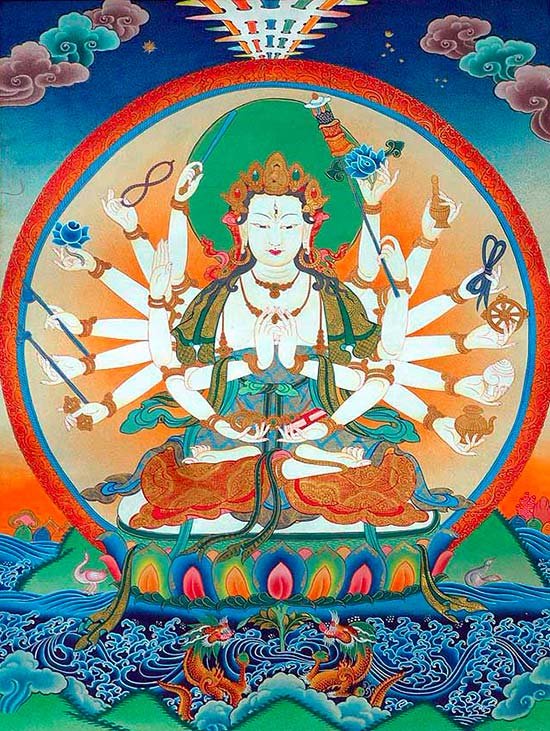Maha Prajnaparamita Sastra
by Gelongma Karma Migme Chödrön | 2001 | 941,039 words
This page describes “the knowledge of the dhyanas, etc.” as written by Nagarjuna in his Maha-prajnaparamita-sastra (lit. “the treatise on the great virtue of wisdom”) in the 2nd century. This book, written in five volumes, represents an encyclopedia on Buddhism as well as a commentary on the Pancavimsatisahasrika Prajnaparamita.
III. The knowledge of the dhyānas, etc.
The power of the knowledge of defilement, purification and the types of trances, liberations, concentrations and absorptions (dhyānavimokṣasamādhisamāpattīnāṃ saṃkleśo vyvadānaṃ vyavasthānam).
By trance (dhyāna) is meant the four dhyānas.
The Buddha knows these dharmas auxiliary to the Path: he knows their name (nāman) and their characteristics (lakṣaṇa), their order and their practice; he knows if they are impure (sāsrava) or pure (anāsrava), in the course of being practiced (śikṣita) or already practiced (aśikṣita), purified (vyavadāta) or defiled (saṃkliṣṭa), with flavor (sarasa) or without flavor (arasa), profound (gambhīra) or superficial, and other distinctions of this kind.
The eight liberations (vimokṣa) have been explained in detail in reference to the dhyānas (above, p. 1291F). The dhyānas include all the meditative stabilizations of the form realm (rūpadhātu); the liberations include all the absorptions (samāpatti) and the perfection of trance (dhyānapāramitā).[1] The vimokṣas, dhyānas, samāpattis and samādhis are ‘concentrations’, and by concentrations is meant the non-distraction of the mind (cittāvikṣepa).
[The Buddha knows their defilement] and by defilement (saṃkleśa) is meant the conflicting emotions (kleśa) such as affection (anunaya), wrong view (dṛṣṭi), pride (māna), etc.
[The Buddha knows their purification] and by purification is meant the true concentrations: those that are not mixed with the conflicting emotions – affection, wrong view, pride, etc. – and that are like real gold.
[The Buddha knows] the types (vyvasthāna): among these concentrations, we must distinguish those where only one mind is functioning, those where several minds are functioning, those that are always functioning and those that do not always function, the concentrations into which it is difficult or easy to enter, difficult or easy to come out of, the concentrations that grasp the characteristics of the object separately or those that grasp them inclusively, the concentrations to be avoided and those not to be avoided.
As concentrations to be avoided, we may cite for example the mind of loving-kindness (maitrīcitta) if one is full of passion, the meditation on the horrible (aśubhabhāvana) if one is full of hate, the meditation on the finite and infinite (antānantabhāvana) if one is stupid, the use of the knowledge and discrimination of dharmas if one is excited, the desire to concentrate the mind if one is depressed. But in the reverse cases, the cited concentrations are not to be avoided.
Furthermore, in regard to the concentrations, time (kāla) and place (sthāna) must be distinguished. If the body is exhausted, that is not the time to practice concentration. This is what the Bodhisattva said when he was practicing austerities (duṣkaracaryā): “Now I am incapable of producing a meditative stabilization.” Also, places where there are crowds are not desirable places to practice concentration.
Furthermore, the Buddha knows the loss (dhvaṃsa) of the dhyānas, the duration (sthiti) of the dhyānas, the increase (vardhana) of the dhyānas and the dhyānas that end up in nirvāṇa.
Furthermore, the Buddha knows those who enter into and come out of concentration with difficulty, those who enter and come out of concentration easily, those who enter easily and come out with difficulty, and, finally, those who enter with difficulty and come out easily.[2]
The Buddha knows that such and such a man should obtain such and such a dhyāna. He knows that such and such a man who has lost the dhyāna is enjoying the five objects of enjoyment (pañcakāmaguṇa). He knows that such and such a man, having enjoyed the five objects of enjoyment, will obtain the dhyāna anew and depending on this dhyāna, he will attain arhathood.
By means of his profound knowledge, the Buddha knows fully these dhyānas, vimokṣas, samādhis and samāpattis, and as this knowledge is intact (avyāhata) and invincible (ajeya) [in him, it is called the third ‘power’.
Footnotes and references:
[1]:
The text here seems to be corrupt.
[2]:
In Saṃyutta, III, p. 272, the Buddha distinguishes four kinds of meditators (jhāyin): the person who is skillful in staying in concentration and unskillful in coming out of concentration (samādismiṃ ṭhitikusalo na samādhismiṃ vuṭṭhānakusalo), etc.
